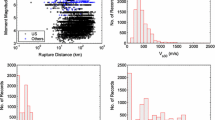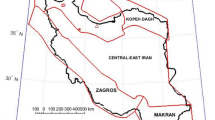Abstract
The relationship between horizontal- and vertical components of earthquake ground motion intensity measure (IM) parameters and also, the correlation between the vertical to horizontal response spectra ratio (V/H) and IMs parameters are currently being studied. 206 records of ground motions for horizontal- and vertical components of earthquakes attained from the PEER strong motion database are used in this study. The moment magnitudes of these earthquake records range from 3.5 to 7.6 with the epicentral distance between 3.6 to 200 km. The site classification of the ground conditions is based on the average shear wave velocity range from 99.93 to 999.66 m/s. Data from earthquake ground motions with varying V/H ratios were used in the regression analysis method. According to these analyses, the cumulative absolute velocity (CAV) parameter is the strong correlation between the horizontal and vertical components of the earthquake and the lowest correlation parameter is the predominant period (Tp). The horizontal and vertical earthquake components have a larger correlation in velocity groups. On the other hand, the correlation values for the displacement and frequency groups are low. In addition, the V/H ratios have a significant correlation with all IM parameters in both horizontal and vertical earthquake components.





















Similar content being viewed by others
References
J.W. Baker, Correlation of ground motion intensity parameters used for predicting structural and geotechnical response, In Applications of Statistics and Probability in Civil Engineering, Kanda, Takada, and Furuta (editors), Taylor and Francis Group, London, England, pp. 1–7 (2007)
B.A. Bradley, Empirical correlation of PGA, spectral accelerations and spectrum intensities from active shallow crustal earthquakes. Earthq. Eng. Struct. Dyn. 40(15), 1707–1721 (2011)
Federal Emergency Management Agency, NEHRP guidelines for the seismic rehabilitation of buildings, Report No. FEMA-356, Washington, DC (2000)
Euro code 8, Design of structures for earthquake resistance, part 1: general rules, seismic actions, and rules for buildings. EN 1998-1, European Committee for Standardization, Brussels, Belgium (2004)
Caltrans, Seismic design criteria (version 1.3). Sacramento (CA 94273-0001, USA): California Department of Transportation (2009)
AASHTO, AASHTO LFRD Bridge design specifications. Washington DC (USA): American Association of State Highway and Transportation Officials (2012)
ASCE/SEI 7–16, Minimum design loads for buildings and other structures, American Society of Civil Engineers (ASCE, 2016)
Y. Bozorgnia, K.W. Campbell, The vertical-to-horizontal response spectral ratio and tentative procedures for developing simplified V/H and the vertical design spectra. J. Earthq. Eng. 8(2), 175–207 (2004)
B. Edwards, V. Poggi, D. Fäh, A predictive equation for the vertical-to-horizontal ratio of ground motion at rock sites based on shear-wave velocity profiles from Japan and Switzerland. Bull. Seismol. Soc. Am. 101, 2998–3019 (2011)
V. Poggi, B. Edwards, D. Fäh, Characterizing the vertical-tohorizontal ratio of ground motion at soft sediment sites. Bull. Seismol. Soc. Am. 102, 2741–2756 (2012)
M.R. Zolfaghari, A. Darzi, A prediction model for vertical-to-horizontal ratios of PGA, PGV, and 5%-damped response spectra (0.01–10 s) for Iran. J. Seismol. 23, 819–837 (2019). https://doi.org/10.1007/s10950-019-09836-z
N.M. Newmark, J.A. Blume, K.K. Kapur, Seismic design spectra for nuclear power plants. J. Power Div. ASCE 99(2), 287–303 (1973)
N.A. Abrahamson, J.J. Litehiser, Attenuation of vertical peak acceleration. Bull. Seismol. Soc. Am. 79(3), 549–580 (1989)
M. Niazi, Y. Bozorgnia, Distance scaling of vertical and horizontal response spectra of the Loma Prieta earthquake. Earthq. Eng. Struct. Dyn. 22, 695–707 (1993)
H. Zafarani, M.R. Soghrat, A selected dataset of the Iranian strong motion records. Nat. Hazards 86(3), 1307–1332 (2017)
A. Khansefid, A. Bakhshi, A. Ansari, Development of declustered processed earthquake accelerogram database for the Iranian Plateau: including near-field record categorization. J. Seismolog. 23(4), 869–888 (2019)
A. Khansefid, Pulse-like ground motions: statistical characteristics, and GMPE development for the Iranian Plateau. Soil Dyn. Earthq. Eng. 134, 106164 (2020)
A. Khansefid, S.M. Yadollahi, G. Müller, F. Taddei, Ground motion models for the induced earthquakes by the geothermal power plants activity. J. Earthq. Eng. (2022). https://doi.org/10.1080/13632469.2022.2084475
Y. Bozorgnia, M. Niazi, K.W. Campbell, Characteristics of free-field vertical ground motion during the Northridge earthquake. Earthq. Spectra 11, 515–525 (1995)
J.W. Baker, B.A. Bradley, Intensity measure correlations observed in the NGA-West2 database, and dependence of correlations on rupture and site parameters. Earthq. Spectra 33(1), 145–156 (2017)
Y. Bozorgnia, K.W. Campbell, Ground motion model for the vertical-to-horizontal (V/H) ratios of PGA, PGV, and response spectra. Earthq. Spectra 32(2), 951–978 (2016). https://doi.org/10.1193/100614EQS151M
J.W. Baker, C.A. Cornell, Correlation of response spectral values for multicomponent ground motions. Bull. Seismol. Soc. Am. 96(1), 215–227 (2006). https://doi.org/10.1785/0120050060
M.R. Zolfaghari, A. Darzi, A prediction model for vertical-to-horizontal ratios of PGA, PGV, and 5%-damped response spectra (0.01–10 s) for Iran. J. Seismol. 23, 819–837 (2019). https://doi.org/10.1007/s10950-019-09836-z
O. Kale, S. Akkar, A new formulation for a code-based vertical design spectrum. Earthq. Eng. Struct. Dyn. (2020). https://doi.org/10.1002/eqe.3272
A. Haji-Soltani, S. Pezeshk, M. Malekmohammadi, A. Zandieh, A study of vertical-to-horizontal ratio of earthquake components in the gulf coast region. Bull. Seismol. Soc. Am. 107(5), 2055–2066 (2017)
S.J. Kim, C.J. Holub, A.S. Elnashai, Analytical assessment of the effect of vertical earthquake motion on RC bridge piers. J. Struct. Eng. 137, 252 (2011)
Y. Djarir, K. Abdelkrim, Seismic response of reinforced concrete frames on flexible foundations subjected to both horizontal and vertical ground motions. Malays. J. Civ. Eng. 24, 202–214 (2012)
E.N. Farsangi, A.A. Tasnimi, The influence of coupled horizontal–vertical ground excitations on the collapse margins of modern RC-MRFs. Int. J. Adv. Struct. Eng. (IJASE) 8, 169–192 (2016). https://doi.org/10.1007/s40091-016-0122-0
A. Dehghanpoor, D. Thambiratnam, E. Taciroglu, T. Chan, Soil-pile-superstructure interaction effects in seismically isolated bridges under combined vertical and horizontal strong ground motions. Soil Dyn. Earthq. Eng. 126, 105753 (2019). https://doi.org/10.1016/j.soildyn.2019.105753
J.M. Liu, T. Wang, S.R. Wu, M.T. Gao, New empirical relationships between arias intensity and peak ground acceleration. Bull. Seismol. Soc. Am. 106(5), 2168–2176 (2016). https://doi.org/10.1785/0120150366
W. Du, G. Wang, Empirical correlations of frequency-content parameters of ground motions with other intensity measures. Soil Dyn. Earthq. Eng. 102, 65–74 (2017). https://doi.org/10.1016/j.soildyn.2017.08.014
R. Garg, J.P. Vemuri, K.V.L. Subramaniam, Correlating peak ground A/V ratio with ground motion frequency content. Recent Adv. Struct. Eng. Lect. Notes Civ. Eng. 2, 12 (2019). https://doi.org/10.1007/978-981-13-0365-4_6
E.A. Elhout, The correlation between the ground motion intensity measure parameters of earthquakes. Asian J. Civ. Eng. 21, 829–840 (2020). https://doi.org/10.1007/s42107-020-00243-1
M.A. Jaimesa, G. Candiab, A.S. López-Castañeda, J. Macedoc, Ground motion correlations from recorded Mexican intermediate-depth, Intraslab earthquakes. J. Earthq. Eng. (2021). https://doi.org/10.1080/13632469.2021.2001393
X. Lu, X. Lu, X. Guan, L. Ye, Comparison and selection of ground motion intensity measures for seismic design of super high-rise buildings. Adv. Struct. Eng. 16(72), 1249 (2013)
Z. Wang, J. Padgett, L. Dueñas-Osorio, Influence of vertical ground motions on the seismic fragility modeling of a bridge-soil-foundation system. Earthq. Spectra 29(3), 937–962 (2013). https://doi.org/10.1193/1.4000170
M.S. Kenari, M. Celikag, Correlation of ground motion intensity measures and seismic damage indices of masonry-infilled steel frames. Arab. J. Sci. Eng. 44, 5131–5150 (2019). https://doi.org/10.1007/s13369-019-03719-8
A. Dehghanpoor, D. Thambiratnam, W. Zhang, T. Chan, E. Taciroglu, An extended probabilistic demand model with optimal intensity measures for seismic performance characterization of isolated bridges under coupled horizontal and vertical motions. Bull. Earthq. Eng. 19, 2291–2323 (2021). https://doi.org/10.1007/s10518-021-01044-w
D. An, Z. Chen, G. Cui, Research on seismic ground motion parameters applicable to the safety of rectangular shallow tunnel. Adv. Mech. Eng. 14(1), 1–10 (2022). https://doi.org/10.1177/16878140211072627
M. Kamal, M. Inel, Correlation between ground motion parameters and displacement demands of mid-rise RC buildings on soft soils considering soil-structure-interaction. Buildings (2021). https://doi.org/10.3390/buildings11030125
https://peer.berkeley.edu/peer-strong-ground-motion-databases
SeismoSignal, version 4.3.0, Pavia, Italy: Seismosoft Ltd. Retrieved from http://www.seismosoft.com/en/HomePage.aspx
ANG, AHS, Reliability bases for seismic safety assessment and design, in Proceedings, Fourth US National Conference on Earthquake Engineering, Earthquake Engineering Research Institute, Palm Springs, I, pp. 29–45 (1990)
J. Douglas, Earthquake ground motion estimation using strong-motion records: a review of equations for the estimation of peak ground acceleration and response spectral ordinates. Earth Sci. Rev. 61(1–2), 43–104 (2003). https://doi.org/10.1016/S0012-8252(02)00112-5
J. McCann, W. Martin, D.M. Boore, Variability in ground motions: root mean square acceleration and peak acceleration for the 1971 San Fernando, California, earthquake. Bull. Seismol. Soc. Am. 73(2), 615–632 (1983). https://doi.org/10.1785/BSSA0730020615
A. Arias, A measure of earthquake intensity, in Seismic Design for Nuclear Power Plants, ed. by R.J. Hansen (MIT Press, Cambridge, 1970), pp. 438–483
J.L. Thun, L.H. Rochim, G.A. Scott, J.A. Wilson, Earthquake ground motions for design and analysis of dams, earthquake engineering and soil dynamics II—recent advances in ground-motion evaluation. Geotech. Spec. Publ. 20, 463–481 (1988)
O.W. Nuttli, The relation of sustained maximum ground acceleration and velocity to earthquake intensity and magnitude," Miscellaneous Paper S-71-1, Report 16, U.S. Army Corps of Engineers, Waterways Experiment Station, Vicksburg, Mississippi (1979)
J.R. Benjamin and Associates, A criterion for determining exceedance of the Operating Basis Earthquake," EPRI Report NP-5930, Electric Power Research Institute, Palo Alto, California (1988)
S.K. Sarma, K.S. Yang, An evaluation of strong motion records and a new parameter A95. Earthq. Eng. Struct. Dyn. 15(1), 119–132 (1987). https://doi.org/10.1002/eqe.4290150109
Electrical Power Research Institute (EPRI), A criterion for determining exceedance of the operating basis earthquake, Report No. EPRI NP-5930, Palo Alto, CA (1988)
G.W. Housner, Spectrum intensities of strong-motion earthquakes, in Proceedings of the Symposium on Earthquake and Blast Effects on Structures, Los Angeles, California, Earthquake Engineering Research Institute, Los Angeles, pp. 20–36 (1952). http://resolver.caltech.edu/CaltechAUTHORS:20161010-155126031
R.K. McGuire, Seismic ground motion parameter relations. J. Geotech. Eng. Div. 104, 481–490 (1978). https://doi.org/10.1061/AJGEB6.0000615
I. Furuya, Predominant period and magnitude. J. Phys. Earth 17(2), 119–126 (1969)
E.M. Rathje, N.A. Abrahamson, J.D. Bray, Simplified frequency content estimates of earthquake ground motions. J. Geotech. Geoenviron. Eng. 124(2), 150–159 (1998)
S. Sarker, D. Kim, M.S. Azad, C. Sinsabvarodom, S. Guk, Influence of optimal intensity measures selection in engineering demand parameter of fixed jacket offshore platform. Appl. Sci. 11, 10745 (2021). https://doi.org/10.3390/app112210745
Funding
There is not any funding source.
Author information
Authors and Affiliations
Corresponding author
Ethics declarations
Conflict of interest
On behalf of all authors, the corresponding author states that there is no conflict of interest.
Additional information
Publisher's Note
Springer Nature remains neutral with regard to jurisdictional claims in published maps and institutional affiliations.
Rights and permissions
Springer Nature or its licensor (e.g. a society or other partner) holds exclusive rights to this article under a publishing agreement with the author(s) or other rightsholder(s); author self-archiving of the accepted manuscript version of this article is solely governed by the terms of such publishing agreement and applicable law.
About this article
Cite this article
Elhout, E.A. The Intensity Measures Parameters of Horizontal and Vertical Ground Motions. J. Inst. Eng. India Ser. A 104, 251–269 (2023). https://doi.org/10.1007/s40030-022-00701-w
Received:
Accepted:
Published:
Issue Date:
DOI: https://doi.org/10.1007/s40030-022-00701-w




